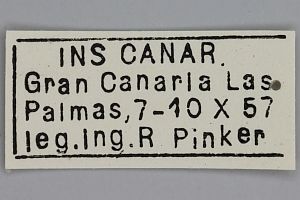

 +1Kontinente:EU
+1Kontinente:EU4. Weitere Informationen
4.1. Andere Kombinationen
- Ambloma klimeschi Gozmány, 1977 [Originalkombination und bis Falck & Karsholt (2023) übliche Kombination]
4.2. Taxonomie
Nach Falck & Karsholt (2023) gehören alle Symmocinae der Kanarischen Inseln und Madeiras zu einer einzigen Gattung: Chersogenes. Sie erklären ferner die zwischenzeitlich als Synonym zu C. canariensis gestellte Epanastasis extricata wieder zur bona species.
4.3. Faunistik
Die Art wurde von La Caleras auf La Gomera beschrieben. Offensichtlich handelt es sich um einen Endemiten der Kanarischen Inseln. Falck & Karsholt (2023: 288) schreiben zur Verbreitung: "Only known from the Canary Islands: Gran Canaria, La Gomera, El Hierro and Tenerife, Spain."
(Autor: Erwin Rennwald)
4.4. Typenmaterial
Gozmány (1977: 268): “Holotype male: “Ins. Canar., La Gomera, La Calera, 15. 4. 1971” 4 paratypes from 5. 4. 1971, La Gomera, La Calera, 8 Paratypes from 15; [sic, recte: .] 4. 1971, same site, and 6 paratypes from 10. 4. 1971, La Gomera, Valle gr. Rey; 10 paratypes deposited in the KCL; 8 paratypes in the HNHM; 2 paratypes in the BM.”
4.5. Literatur
- Falck, P. & O. Karsholt (2023): The Symmocinae and Holcopogoninae in the Canary Islands and Madeira, with descriptions of 13 new species (Lepidoptera: Autostichidae). — SHILAP Revista de lepidopterología, 51 (202): 269-314. https://doi.org/10.57065/shilap.462. [zum PDF-Download auf shilap.org]
- Erstbeschreibung: Gozmány, L. (1977): New Symmocid species (Lepidoptera) and the description of an unknown abdominal organ. — Acta zoologica Academiae Scientiarum Hungaricae 21 (3-4): 263-269. [Digitalisat auf archive.org]





